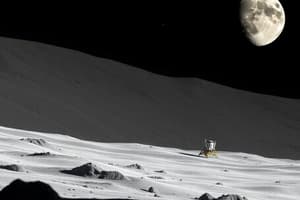Podcast
Questions and Answers
What significant event occurred on June 25, 2024, involving China's Chang'e 6 lunar probe?
What significant event occurred on June 25, 2024, involving China's Chang'e 6 lunar probe?
- The spacecraft was launched.
- China established a lunar research facility.
- The capsule successfully returned lunar soil samples to Earth. (correct)
- Soil samples from the Moon's near side were collected.
What is the South Pole-Aitken (SPA) basin on the Moon known for?
What is the South Pole-Aitken (SPA) basin on the Moon known for?
- Its abundant liquid water reserves.
- Hosting the first human landing site.
- Being the hottest region on the Moon.
- Being one of the largest and oldest impact craters in the Solar System. (correct)
Which material was used for the flag planted by the Chang'e 6 lander?
Which material was used for the flag planted by the Chang'e 6 lander?
- Basalt. (correct)
- Plastic fabric.
- Aluminum.
- Silk.
What is the estimated weight of the lunar material collected by the Chang'e 6 mission?
What is the estimated weight of the lunar material collected by the Chang'e 6 mission?
What future missions does China have planned after the successful Chang'e 6 mission?
What future missions does China have planned after the successful Chang'e 6 mission?
How did the Chang'e 6 spacecraft transport samples back to Earth?
How did the Chang'e 6 spacecraft transport samples back to Earth?
What is one of the reasons scientists are excited about the lunar samples returned by Chang'e 6?
What is one of the reasons scientists are excited about the lunar samples returned by Chang'e 6?
What was the launch date of the Chang'e 6 mission from China?
What was the launch date of the Chang'e 6 mission from China?
Flashcards
What was the significance of the Chang'e 6 mission?
What was the significance of the Chang'e 6 mission?
The Chang'e 6 mission successfully retrieved soil samples from the Moon's far side, marking the first time materials have been brought back from this unexplored region.
What is the SPA Basin?
What is the SPA Basin?
The South Pole-Aitken (SPA) basin is a massive impact crater on the Moon's far side, notable for its size (1,600 miles wide) and age, making it one of the oldest and largest in the solar system.
What is the scientific purpose of collecting lunar samples from the far side?
What is the scientific purpose of collecting lunar samples from the far side?
The mission's goal was to collect samples of rocks and soil from the SPA basin to study the Moon's evolution, particularly its far side. The data from these samples could also provide insights into the differences between the near and far sides of the Moon and even the early history of our solar system.
What symbolic act did the Chang'e 6 mission perform on the Moon?
What symbolic act did the Chang'e 6 mission perform on the Moon?
Signup and view all the flashcards
How did the Chang'e 6 mission collect lunar samples?
How did the Chang'e 6 mission collect lunar samples?
Signup and view all the flashcards
Describe the process of returning the lunar samples to Earth.
Describe the process of returning the lunar samples to Earth.
Signup and view all the flashcards
What are China's future plans for lunar exploration?
What are China's future plans for lunar exploration?
Signup and view all the flashcards
Who is the Chang'e 6 spacecraft named after?
Who is the Chang'e 6 spacecraft named after?
Signup and view all the flashcards
Study Notes
Chang'e 6 Lunar Mission
- Chang'e 6 probe successfully collected lunar soil samples from the Moon's far side on June 25, 2024.
- This is the first successful sample return from the unexplored far side.
- Launched from Hainan, South China on May 3, 2024.
- Landed at the South Pole-Aitken (SPA) basin on the far side on June 2, 2024.
- Launched a national flag (basalt, 12x8 inches) during the mission.
- Collected rocks and soil samples using a drill and robotic arm.
- Captured high-quality images of the lunar surface.
- Deployed sample return rocket on June 4, 2024 to bring the samples back to Earth.
- Return capsule landed in Inner Mongolia on June 25, 2024.
- Approximate sample weight: 4 pounds (2 kg).
- Chinese officials intend to share samples with researchers globally for analysis.
South Pole-Aitken Basin
- Located on the Moon's far side.
- Approximately 1,600 miles (2,500 km) wide and 5 miles (8 km) deep.
- One of the largest and oldest impact craters in the Solar System.
Future Lunar Missions
- Chang'e 7 (2026 launch): Focus on searching the Moon's south pole for water and resources.
- Chang'e 8 (2028 launch): Planned as a follow-up mission to Chang'e 7 to support further exploration of the Moon's south pole.
- Crewed Moon missions slated for 2030.
- Goal to establish a permanent lunar base at the South Pole.
Studying That Suits You
Use AI to generate personalized quizzes and flashcards to suit your learning preferences.





